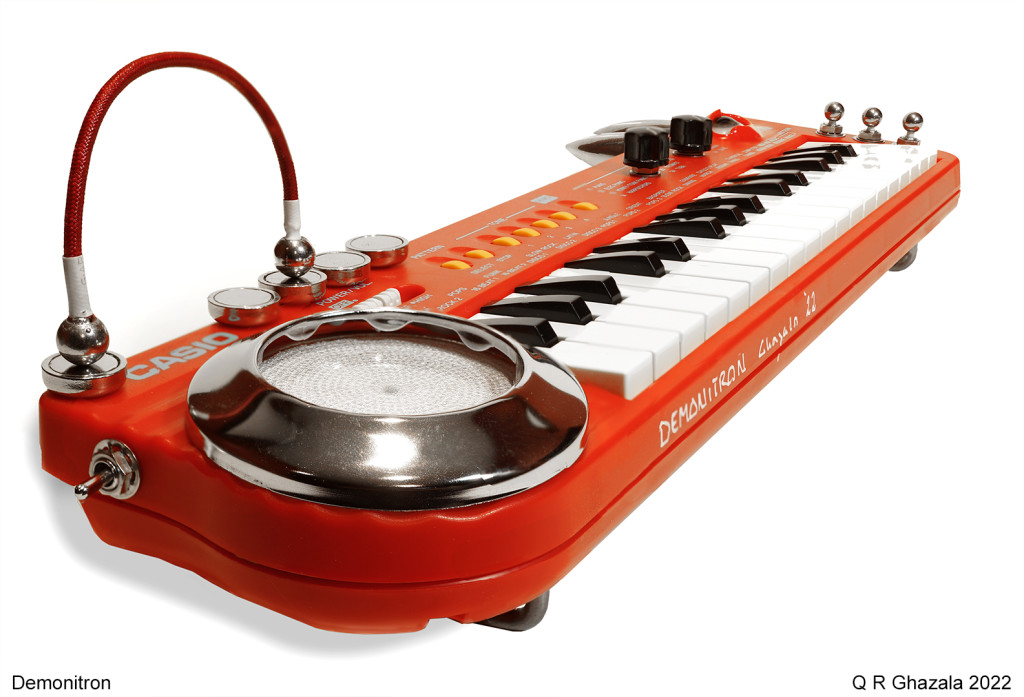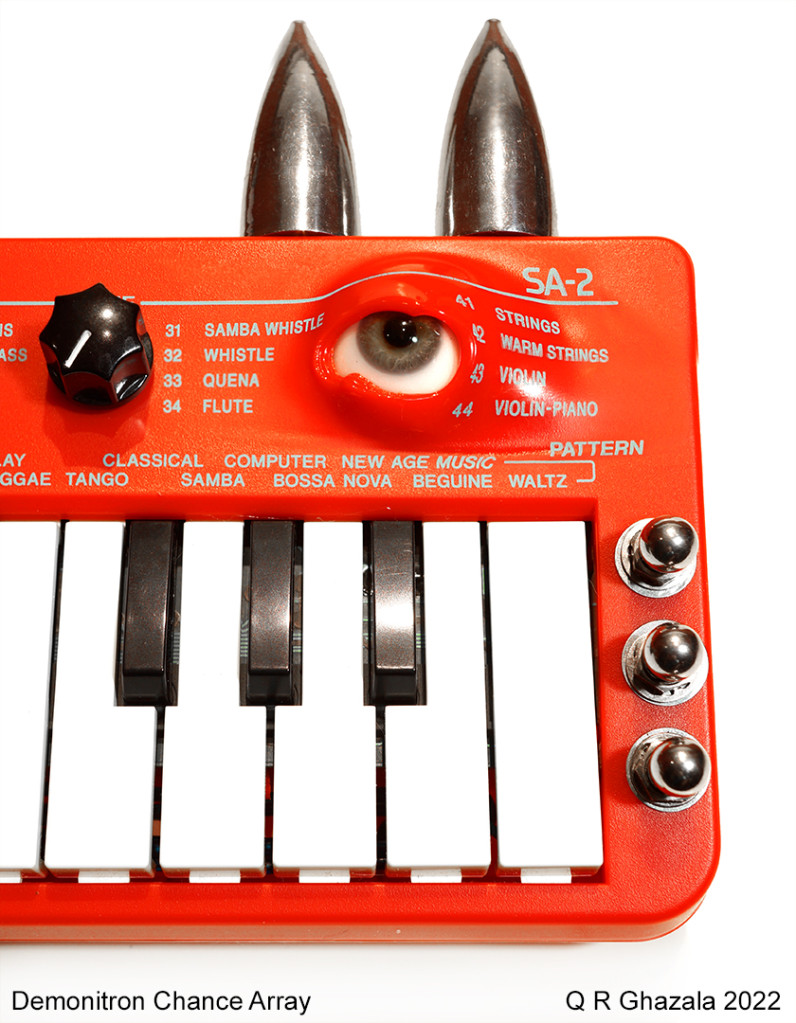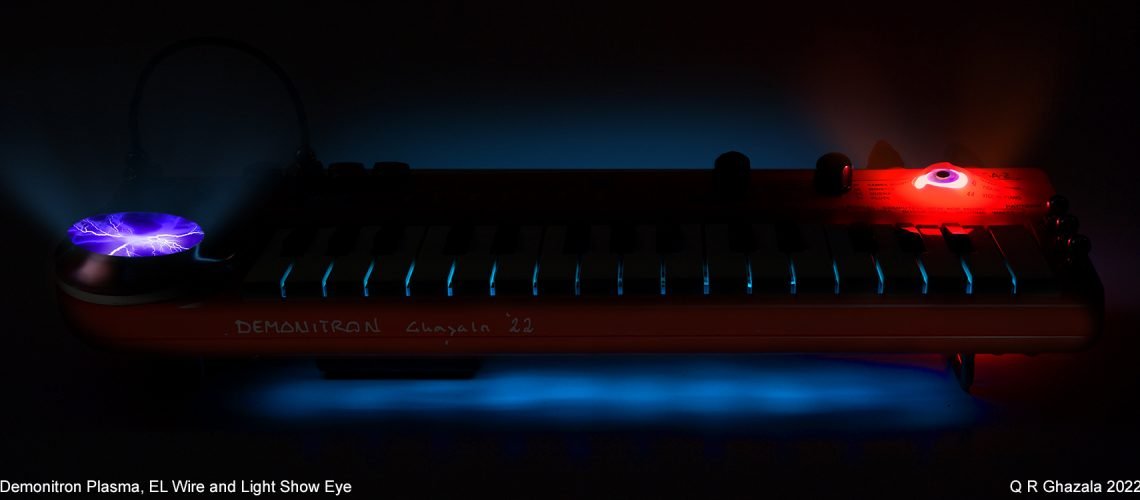“Father of Circuit Bending” Reed Ghazala isn’t done transforming musical bending techniques. For starters, there’s this magnetic-patch, chip-talk, chance-based aleatron reincarnation of a Casio keyboard – now with plasma-based radiation. You know, like the energy weapons in sci-fi films. Oh, and a glass eyeball and underlighting.
Yeah, to anyone bored with current electronic music instruments – meet The Demonitron. And packed with fresh ideas about bending and instrument re-imaginings, it also takes us “beyond the blob” by going past the bubbles intended to protect proprietary chip designs. That’s even before it starts messing with plasma and radiation.
For reference, here’s what an unmodified SA-2 sounds like – compare the results at the bottom.

Reed has an extensive narrative about how this was created. Reprinted on CDM by permission of the author.
So, last spring I mentioned new bending tech I wanted to share.
Unbelievable complications in my life have delayed the post, bringing you auctions, chipmunks and skeletons instead. But here now is the Demonitron, my newest aleatron with the very cool features I want to bring forward, bent-tech you can easily use in your own bends.
As it usually goes in anti-theory electronics, we’ll be breaking more rules, even prompting a War of the Worlds vs. the FCC scenario. Haha, yeh.
So, the blob is impenetrable, right?
Nay.
That epoxy dot protecting the correct operation of diligent circuitry is no more. We’re in.
And… there’s a single audio output, right where the designer of the circuit says it is, right?
Nay.
That instrument you’re working on right now probably has lots more to say. Why not listen?
Before I shatter these two concepts, let’s look at the Demonitron’s general features.

“That epoxy dot protecting the correct operation of diligent circuitry is no more. We’re in… That instrument you’re working on right now probably has lots more to say. Why not listen?”
This is an aleatron (keyboard-based chance-bent, chance-music engine) based on the outrageously-productive Casio SA-2, in this example a rather rare red version of the usually grey instrument.
Not just striking, the red color supports the “demon” theme, accentuated by the two chrome horns above the creature’s glass eye. These are, of course, body contacts, and very sensitive –– touching these horns can start the chance music all by themselves without hitting the chance trigger at all.
While the SA-2 aleatron can be reset by turning it off and back on, and while the initial music can be started with a Casio mini-button, I’ve replaced these operations with more sure, high-quality mini pushbuttons. And I’ve customized these switches with steel balls to stay in theme with the spheres of the mag-patch bay (more in a moment).

The third switch on the Demonitron’s far right, in line with and finished similarly to the Play and Reset switches, is the Chance Trigger, tapped to set the aleatoric music in motion.
In conjunction with the Chance Trigger push-button is the Threshold dial, the closest dial to the switch bank. The higher this dial is turned, the greater the influence of the Chance Trigger on the circuit as it initiates the program disruptions.

Mag-Patch
The mag-patch system has come a long way since my first discovery and use way back in the 1960s.
In that example, I simply bridged the two chrome body contacts of the Odor Box with a small magnet. Adding a wire to this concept seemed obvious, and you’ve since seen my examples and tutorials online as well as later knock-offs — valid concept.
Here, in the Demonitron, I’ve reversed the ferrous/magnet relationship.
In my past examples of the mag-patch cord, I have magnets soldered to the ends of the cord, and these are meant to mate with ferrous contacts on the instrument. Here, however, the ends of the patch cord are topped with ferrous steel balls, nicely chromed, and the magnets, wired to the circuit, are secured to the instrument. Works wonderfully.
The mag-patch bay is 4-channel. Across from the “emitter” magnet are four “collector” magnets. Via the mag-patch cord placement, the emitter’s pulse can be fed to any of the four collectors, each capable of closing bending’s unintended circuits and, in combination with the Chance Trigger, sending the SA-2 into its improbable musical convulsions.

Eyes and light
Illuminating the red SA-2 is fun; the red models transmit light more easily than the grey versions and I took advantage of this in the eye mounting.
You might know that, long ago, I located an eye-maker in Germany whose profession was to create ocular prosthetics for the German medical industry. Fake human eyes. Exquisite. [Ed.: Reed has confirmed these are glass eyes.] The one I’ve mounted in the Demonitron is color-light-show back-lit as well as music-responsive, and the translucence of the red plastic extends the glow around the eye, further naturalizing its eruption into the aleatron.
Placing the instrument on stands invites under-lighting. To contrast the red of the Demonitron I’ve installed blue EL wire (glowing electro-luminescent tubing) beneath the keys, and below the EL wire I’ve drilled holes in the case bottom to emit this light. Cool, eerie glow in a dark room, or set it to flash with the chance music patterns running for extra confusion.
OK. Here we go…
You’ve heard of chip tunes. But how about chip talk?
I’m now incorporating this concept into various instruments. Chip Talk.
Sure, the circuit designer of the toy you’re working on made things flow from beginning to end, usually with the finish-line as the speaker or line output. That makes things very easy for the casual user.
But we circuit-benders are not casual users, so why should we be content with someone else’s finish line?
We are known to find our own finish lines, certainly in the form of new electronic behavior. So why accept the designer’s idea of “output” on the “board level” if we’ve already re-defined output on the instrument level?
In reality, along with the original design’s declared output, there’s lots of voltage activity happening on the way to that output, potential audio activity –– and that’s what we’re after.
Drop a scope’s probes on the line-out of an active circuit and you’ll see voltage variations within small range. That’s the music. Now drop the probes somewhere else, here and there, anywhere, on the circuit, and somewhere you’ll probably discover similar variations.
Well, that’s the music too. Not the intended music. But music.
What??? What kind of music?
My kind.
You may find weird variations of the musical output, running in synch, but somehow different.
You’ve heard of chip tunes. But how about chip talk?

Maybe just distortions (mix this with main signal for unique tones). Maybe drones that change at unexpected times (smooth these with delays, echo, reverb). Or silence with occasional digital rattles and chirps. Weird.
Or? Well, who knows? You have an ear to an unexpected speaker whose songs and language are all yours to discover. Hear words never meant to be spoken, music never meant to be heard.
How is this done? Where are the sounds?
In simplest form, you use a small bench amp, a “buffer box” (500k potentiometer in a small box), and a custom-made probe set.
Probe set: Cut one end of a 1/8” jack audio cord off, replace the jack with two probes, one soldered to the common wire, one to the hot.
Plug the other end into the buffer box (this s just a signal flow-thru box with a pot in the middle) and another audio cord from the box to the small amp.
Turn the pot down maybe halfway and begin exploring the circuit with the probes to see what you can hear. Adjust the pot as per discovery to set a volume level for observation. Chart your discoveries.
If a signal is too hot (loud), use a trimmer to bring it into audio voltage range.
You might start with the ground probe on a circuit ground and explore with the “hot” lead. But I find audio signals otherwise as well.
Terminate these discovered signals with the audio jacks of choice, numbered or somehow labeled on the instrument.

CAUTION
There can be some pretty hot signals on the board. And as these signals are not meant to be audio signals they may contain artifacts and other surprises that your amp is not expecting. So proceed with caution.
End game is that you now have multiple signals where there was only one, and these can be combined with each other or used singly for new voices. We’re quite overboard here. So I know you’ll love it.
Now,
Energy-beam weapons like in War of the Worlds were at one time limited to science fiction. No more.
The electromagnetic spectrum has real-time and contemporary abusers, with the military around the world right now trying to perfect weapons that invisibly, and from a distance, will turn you into porridge.
And the FCC is aware of invisible electromagnetic propagation, as you know, and cautions us all to heed their warnings and to use the devices in their way.
Wrong.
It’s my device, I own it and I will use it in MY way.
If these guys can’t regulate energy, and designers allow leakage, well it’s on them. Not me. Warnings are ink, ink is paint, and you need to be smarter than paint.
H. G. Wells take heart, invisible rays are here!
Radiation bending, despite the FCC’s warning, is a goodie. At least if you’re a bender.
Here’s what happened.
Energy-beam weapons like in War of the Worlds were at one time limited to science fiction. No more … H. G. Wells take heart, invisible rays are here!
You might remember the Plasma Trigon, an over-the-top Trigon Incantor with a plasma display built-in. That’s pretty current, but my plasma experience roots itself in the early 1970s when I built and publicly displayed one of the first touch-responsive plasma globes anywhere.
Between then and now I’ve used plasma light for photography, examined neon plasma fields of various types, experimented with Violet Ray Generators, published a plasma instrument (Thereglypy, youtube) and I’ve pretty much had plasma around me for decades. So I was in for a surprise. A very frustrating trial. But a VERY cool surprise.
After installing the plasma chamber into the Demonitron I immediately discovered that switching it on killed the instrument. Turned it right off. Not good.
I’ve seen this before in the example of two instruments sharing the same power supply. If voltage or amperage isn’t sufficient, while either instrument might work just fine alone, switching the other on will draw too much energy and the we have system failure of one type or another.
Separate power supplies are a sure fix; a plasma-specific supply was added to the bottom of the instrument in a customized bio-hazard enclosure. I was sure this would work as it has before.
Nope! As soon as I turned the plasma on, same result: crashed Demonitron.
What??? Mind blown. Uh…
H. G. Wells… FCC… porridge. Ah!
Must be! The radiation from the plasma display must be interfering with the Demonitron’s ICs causing a shut-down. What to do?
How about weaken the plasma’s radiation, tune-down its power and thereby its “radio pool,” its pool of RF energy (again, see my radio pool Theregylph plasma instrument, youtube).
Easiest way to do this is to vary the plasma’s voltage. And the easiest way to accomplish this variance is a simple pot on the power supply. The “Radiation” dial on the Demonitron is exactly that.

So, what I expected was to find a “sweet spot” where the display would still glow brightly enough to be interesting, but not so powerful as to kill the circuit.
However that expected, and rather mundane bench result, didn’t happen.
What happened, instead, was a huge leap forward in circuit-bending tech: radiation-bending. Or rad-bending for short.
As I turned-up the plasma’s power dial, yes, I got a nice glow and the plasma arcs became satisfactorily active.
How bright will it get? I know you’re ahead of me cuz I know you guys so well
Yes, as I cranked the plasma a threshold was reached, that being the trigger radiation level, and instead of crashing the circuit the SA-2 went into a splendid array of aleatorics, and I laughed out-loud in amazement.
Plasma-bending. Rad-bending. Whatever.
But that moment took me back 55 years to my original moment of discovery, the shock of that teenager witnessing the chance-creation of my first bent instrument in my trashy desk drawer. Astonishment. Glee!

Did you hear that? That noise coming from inside that instrument next to you? That gasp?
Well, that’s the black blob you couldn’t get into. Until now
Rad-bending should penetrate the blob in various devices, as it does the ICs in the Demonitron, permeating its epoxy firewall non-destructively and with ease.
In my example here, the frequency of the plasma radiation is undetermined. Should I want to expand upon this idea I would certainly try various generators of RF energy with variable power and frequency to, perhaps, affect various functions of the blob resulting in assorted bends.
While the Demonitron works smoothly by means of the mechanical and touch controls, the addition of radiation-bending feels like a natural extension. The variability of plasma power allows integration with the other controls. And the radiation’s intrusion into the Demonitron’s programs seems the gentlest bending tool yet, relying, like the theremin, upon the invisible.
Just be careful with those energy beams, kids. You’ll poke your eye out.
Here are some Aleatrons in a bench tests. Yeah, the sounds are beautiful – seems we need an album of this stuff.
The Chance Orchestrion combines the sounds of two of these in a single instrument:
Let’s finish with some meditation, since meditation has been a topic:
Previously – the topic of “Errorism” on CDM:




